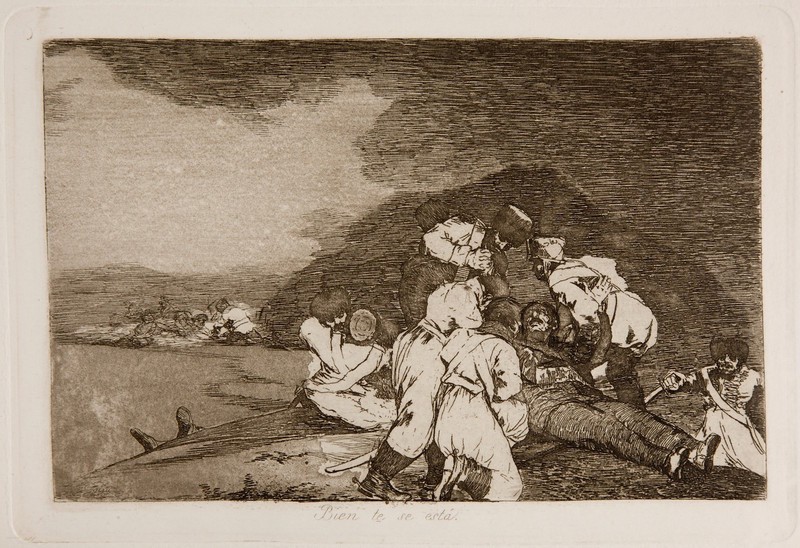- Cronología
- Ca. 1810 - 1815
- Dimensiones
- 144 x 209 mm
- Técnica y soporte
- Etching, lavis and burin
- Reconocimiento de la autoría de Goya
- Undisputed work
- Ficha: realización/revisión
- 25 Nov 2010 / 24 May 2023
- Inventario
- 225
Goya (lower left-hand corner), 26 (lower left-hand corner).
See Sad presentiments of what must come to pass.
According to Tomás Harris, there exist several state proofs of this work. The first, made before the number was engraved on, contains some retouching in burin to the head of the wounded soldier and on the upper portion of the kneeling soldier. By the time the next state proof was made, the lavis (or open-bite etching) had been added over the entire copperplate. Later on a new state proof was made, now including the engraved number 26.
The title was handwritten by Goya on the first and only print run that we know to have been made at the time, and which the painter gave to his friend Agustín Ceán Bermúdez. The title was engraved on to the copperplate at a later date, and no other modifications were made to the image for the first edition of the Disasters of War, which was printed by the Royal Academy of Fine Arts of San Fernando, Madrid, in 1863.
No preparatory drawing has been conserved.
In a dark landscape, possibly at night, a French commander has fallen in battle. According to some experts, Goya has depicted in this print his interpretation of the fall of General Pierre-Antoine Dupont (Chabanais, 1765-Paris, 1840), who was killed at the battle of Bailén. At that battle, which took place in the early hours of 19 July 1808, the French contingent were defeated by troops under the Spanish general Castaños (Madrid, 1758-Madrid, 1852). This represented a key moment in the Spanish War of Independence since it was the first time that Napoleon's army had been beaten in a pitched battle.
In the lower right-hand corner of the print we see the dying figure, surrounded by a number of his soldiers. The soldier at the top of the group is clasping his hands together as if praying for the life of the French commander.
With this image Goya points to the inevitability of death, an obvious consequence of war, and something that can lie in wait for and surprise anyone, no matter their rank. In this case, the title of the print, It serves you right, is another indication that the artist considered this death to be more justified than many others.
By means of a persistent use of tightly-packed horizontal lines etched into the copperplate, the artist has built up the clouds and the mountains in the background, concentrated around the dying soldier like an ill-fated halo which reveals his hopeless future. The dark tones used in the body and face of the wounded man contrast sharply with the brilliance of the soldiers, dressed in much brighter clothing, that surround him.
According to Enrique Lafuente Ferrari, this print can be related to other scenes featuring people wounded in battle or receiving treatment: no. 20, Treat them, then on to other matters, no. 24, They'll still be useful and no. 25, So will these. Goya probably intended to draw a comparison between this French commander, portrayed in his dying moments, and all those others, of lower rank, who find themselves in the same situation.
The etching plate is conserved in the National Chalcography Museum (cat. 257)
-
De grafiek van GoyaRijksmuseum RijksprentenkabinetAmsterdam1970from November 13th 1970 to January 17th 1971cat. 58
-
Francisco de GoyaMuseo d'Arte ModernaLugano1996exhibition celebrated from September 22nd to November 17th.cat. 6
-
Francisco Goya. Sein leben im spiegel der graphik. Fuendetodos 1746-1828 Bordeaux. 1746-1996Galerie KornfeldBern1996from November 21st 1996 to January 1997cat. 95
-
Francisco Goya. Capricci, follie e disastri della guerraSan Donato Milanese2000Opere grafiche della Fondazione Antonio Mazzottacat. 86
-
Goya. Opera graficaPinacoteca del Castello di San GiorgioLegnano2006exhibition celebrated from December 16th 2006 to April 1st 2007p. 54
-
Goya et la modernitéPinacothèque de ParisParís2013from October 11st 2013 to March 16th 2014cat.45
-
Goya, grabadorMadridBlass S.A.1918cat. 108
-
Goya engravings and lithographs, vol. I y II.OxfordBruno Cassirer1964cat. 126
-
Vie et ouvre de Francisco de GoyaParísOffice du livre1970cat. 999
-
Catálogo de las estampas de Goya en la Biblioteca NacionalMadridMinisterio de Educación y Cultura, Biblioteca Nacional1996cat. 190
-
ParísPinacoteca de París2013p. 122
-
Goya. In the Norton Simon MuseumPasadenaNorton Simon Museum2016pp. 114-151
